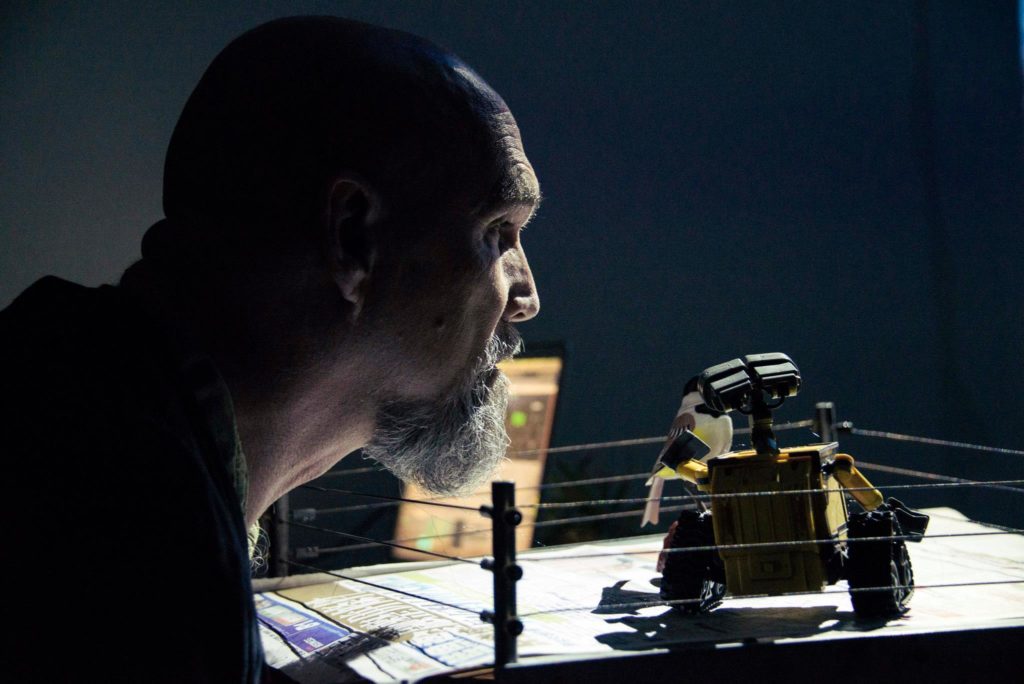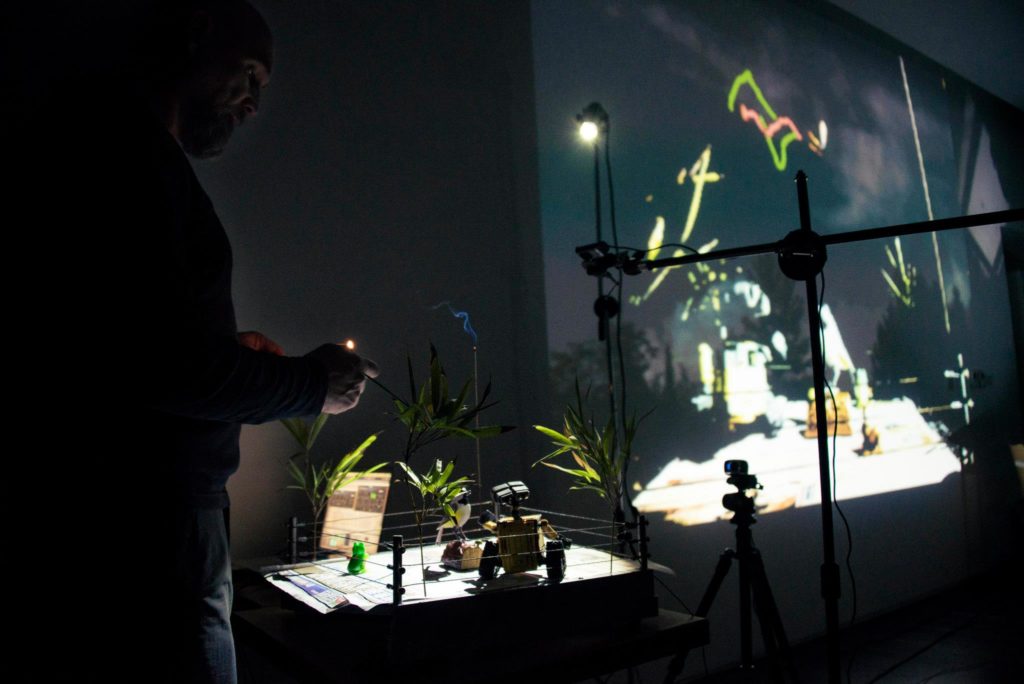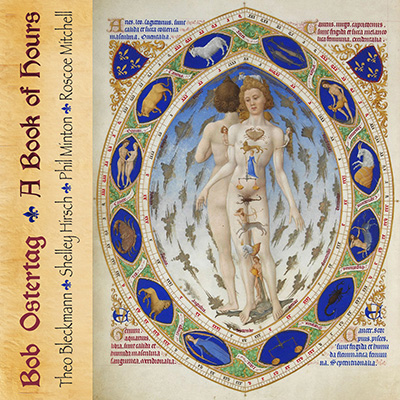
Living Cinema was a 16-year live performance duo of Bob Ostertag and Quebecois artist and animator Pierre Hébert.
The first performance took place at the Yerba Buena Center for the Arts in San Francisco in 2000, and the last at the Teatro Colon in Buenos Aires in 2016. Altogether Living Cinema performed 80 concerts in Europe, North and South America, Asia, and the Middle East. Major venues and festivals included the Buenos Aires Festival Internacional de Cine Independiente, Lincoln Center (New York), Encontros de Cinema (Faro, Portugal), Red Cat Theater (Los Angeles), Sensoralia Festival (Rome), Festival du Nouveau Cinéma (Montreal), The Rotterdam International Film Festival, the School of Creative Media (Hong Kong), and the Sons d’Hiver Festival (Paris).

Beginning the late 1960s, Pierre Hébert had been experimenting with animation as live performance, creating frame-by-frame animation by carving directly on 16mm film with a knife while on stage. Over the years, he developed virtuosic skill at this unique craft. He often performed in duo with improvising instrumentalists, including Bob Ostertag.

In 1999, Ostertag’s friend Joshua “Kit” Clayton was developing what would eventually become the well-known video processing language known as Jitter. He showed his work to Ostertag, who quickly saw how Clayton’s software could be used to allow Hébert to take the techniques he had developed for years scratching on film with a knife, and apply them to any medium he wished, capturing the images with a video camera and projecting them as he went. The software Ostertag created become the core tool of Living Cinema, and enabled Ostertag to assemble the sound on stage in parallel to the image. Living Cinema’s first work, Between Science and Garbage, is likely the first ever work made using Jitter, long before the software was on the market and even before it was in beta. The constant evolution of this software, in response to its continual use during performance, became an integral part of the evolution of Living Cinema.
However, the Living Cinema esthetic was never about the amazing marvels of the digital age. Instead, Living Cinema used the process of live animation as transparent as possible by constantly staging the confrontation between the bodily actions of the performers and the processing power of the machines for all to see. Performances became tense and volatile, with human performers frantically attempting to keep up with the technology’s demand for more input of image and sound, mirroring the increasingly frantic life of the citizens of the digital world.

After some exploratory performances in early 2001, Living Cinema found its legs at a concert at The Walker Center for the Arts in Minneapolis on September 20, 2001, days after the attack on the World Trade Center in New York. It was at this concert that the performers learned the power of live video performance as a commentary on world events. Cinema created on stage during performance cannot compete with conventional cinema in many ways, but it can respond to world events in ways movies which spend months or years in production cannot.

Between Science and Garbage eventually became a DVD released by John Zorn’s Tzadik label. This was followed by Endangered Species, Shadow Boxing, and other works. But each piece was really a sort of framework for constructing a live cinema performance, the content of which would constantly evolve in response to the world news. By the end of the Living Cinema project, concerts would begin with the projected image of the front page of the newspaper of whatever city the performance was in.
Ostertag devotes a chapter to Living Cinema in his book Creative Life: Music, Politics, People, and Machines.




Videos
Ostertag and Hébert always had mixed feelings about recordings of Living Cinema concerts. At the concerts, it was clear that this was a live performance created on stage in precarious technical conditions which could break down at any time. It was frantic, fraught, and funny. When watching a video recording of a Living Cinema concert, however, the viewer is placed in the same position as when watching movies that took years to make and in which every edit was fine tuned over many months. When judged the criteria of conventional cinema, Living Cinema recordings fail. However, now that Living Cinema is no longer performing, these recordings are what is left. Please watch them keeping in mind that Living Cinema was intended as a live performance, and being present at the performance was very different from watching the recorded artifact.
The complete Between Science and Garbage, released on Tzadik, here in 2 parts:
Living Cinema Performances
- Teatro Colon, March 11 2016, Buenos Aires.
- The Reading Room,, April 27 2013, Bangkok, Thailand.
- Pongnoi Community Art Space,, April 23 2013, Chiang Mai, Thailand.
- ATK/Club Cama, April 17 2013, Hanoi, Vietnam.
- School of Creative Media, Hong Kong City University, April 9 2013, Hong Kong.
- SPOT Huashan Cinema 2F, April 5 2013, Taipei, Taiwan.
- Beicangmen Live Art Center, March 28 2013, Wuxi, China.
- WAVE, March 27 2013, Suzhou, China.
- Paul’s Pocket, March 25 2013, Hefei, China.
- The Blue Fruit, March 24 2013, Nanjing, China.
- 2Kolegas, March 23 2013, Beijing, China.
- The Music Gallery, October 13 2012, Toronto.
- International Beethoven Project, world premiere of September 15 2012, Chicago.
- Blue Mountain Center, «Shadow Boxing» presented as a work in progress to the residents of the center, September 12 2012, Adirondaks, New York State.
- Perugia Contemporary Art Festival Le Arti in Citta, September 26 2009.
- CNMAT, April 23 2009, Berkeley, California.
- Halifax Independent Filmmakers Festival, April 3 2009, Halifax.
- Tel Aviv, Israel, February 7 2009.
- Ouganda, Jerusalem, Palestinian occupied territory, February 4 2009.
- Palais des Beaux-Arts, January 30 2009, Brussels.
- Sons d’hiver, January 26 2009, Paris.
- Rotterdam International Film Festival, January 24 2009, Rotterdam.
- Soundplay Festival, October 25 2008, Toronto.
- Modern Art Museum of Fort Worth, October 18 2008, Forth Worth, Texas.
- Buenos Aires Festival Internacional de Cine Independiente, April 15 2008, at 9 Julio theater, Buenos Aires, Argentina.
- Harvest Works, March 27 2008, New York City.
- San Francisco International Film Festival, May 4 2007, San Francisco Museum of Modern Art.
- Irtijal, April 3 2007, Monnot Theater, Beirut, Lebanon.
- Transart Festival, October 7 2006, Bolzano, Italy.
- Guelph Jazz Festival, September 6 2006, Macdonald Stewart Art Center, University of Guelph, Canada.
- Mondavi Center for the Performing Arts, May 27 2006, University of California, Davis. USA
- IX Encontros de Cinema, December 10 2005, Faro, Portugal.
- Kunsthalle, July 16. 2005, Dusseldorf, Germany.
- Open Ear Festival, April 28, 2005, Kitchener, Canada.
- Red Cat Theater, April 16 2005, Los Angeles, USA.
- High Performance Rodeo, January 28/29 2005, Canada.
- Sensoralia Festival, January 19 2005, Teatro Paladium, Rome, Italy.
- Zo centro culture contemporanee, January 16 2005, Catania, Italy.
- Cultural services of the Municipality of Casares, October 30 2004, Spain.
- Argos Festival, October 22 2004, Brussels, Belgium.
- Evergreen State College, October 16, 2004, Seattle, USA.
- New Forms Festival, October 14 2004, The Western Front, Vancouver.
- Intersection for the Arts, September 16.17,18, 24 and 25 2004, San Francisco.
- Vasistas, February 21/22 2004, Théâtre de La Chapelle, Montreal, Canada.
- Mois Multi, February 14 2004, Méduse, Québec, Canada,
- Modavi Center for the Performing Arts, January 27 2004, University of California, Davis, USA.
- Festival Cinémaa d’Europe, December 12 2003, Cinéma Jean-Vigo, Nice, France.
- Festival Area Sismica, December 7 2003, Municipal Theater, Meldola, Italie,
- Yamaha Avenue Hall, November 13 2003, Sapporo, Japan.
- Chukyo University, November 11 2003, Toyota, Japon.
- Aichi Art Center, 11 November 2003, Nagoya, Japon.
- Osaka Arts-Aporia , 8 November 2003, Red Brick Wharehouse, Osaka, Japon.
- Star Pine’s Cafe, 7 November, 2003 Tokyo, Japon.
- Alliance Française, September 13 2003, Centro de las Artes, Monterrey, Mexico,
- Marathon against the war in Iraq, March 13 2003, Vooruit, Gent, Belgium.
- Fundacao Serralves, with Theo Bleckmann, March 9, 2003, Porto, Portugal.
- Film Kunst Museum, March 7 2003, Ulm, Germany.
- E-M Arts Gallery, March 5 2003, Naples, Italy.
- Area Sismica, March 2 2003, Meldola, Italy.
- Slovenska Kinoteca (Cinémathèque of Slovania) March 1 2003, Ljubljana, Slovénie.
- ICA (Institute for Contemporary Art), February 24 2003, London.
- National Review of Live Art, February 21-22 2003, Glasgow.
- Sons d’hiver, February 4 2003, Paris.
- Rotterdam International Film Festival, February 2 2003.
- Lincoln Center, January 9 2003, New York, USA.
- Steim, November 23 2002, Pompoen Theater, Amsterdam, Netherland.
- Frictie Festival, November 20 2002, Vooruit, Gent, Belgium.
- Konfrontationen Festival, July 21 2002, Nickelsdorf, Austria.
- FIMAV (International Festival of New Music) May 19 2002, Victoriaville, Canada.
- FCMM (New Cinema Festival), October 19 2001, Museum of Contemporary Art, Montreal, Canada.
- Walker Art Center, September 20 2001, Minneapolis, USA.
- I Concerti nel parco, June 21 2001, Rome, Italy.
- Kulturhaus I.M. Eimer, June 20 2001, Berlin, Germany.
- Szczecin, June 19 2001, Poland.
- Jazzateller, June 16 2001, Ulrichsburg, Austria.
- KIBL, June 15, 2001, Maribor, Slovania.
- Aula Magana Tolentini, June 14 2001, Venice, Italy.
- San Francisco Electronic Music Festival, May 5 2001, San Francisco, USA.
- Images Festival, April 13 2001, Toronto, Canada.
